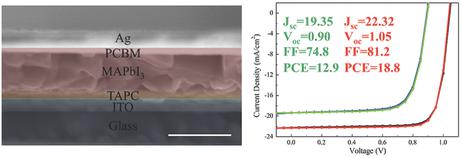当前位置:
X-MOL 学术
›
Adv. Funct. Mater.
›
论文详情
Our official English website, www.x-mol.net, welcomes your
feedback! (Note: you will need to create a separate account there.)
Conjugated Small Molecule for Efficient Hole Transport in High‐Performance p‐i‐n Type Perovskite Solar Cells
Advanced Functional Materials ( IF 18.5 ) Pub Date : 2017-07-17 , DOI: 10.1002/adfm.201702613 Liyan Yang 1, 2 , Feilong Cai 1, 2 , Yu Yan 1, 2 , Jinghai Li 1, 2 , Dan Liu 2 , Andrew J. Pearson 3 , Tao Wang 1, 2
Advanced Functional Materials ( IF 18.5 ) Pub Date : 2017-07-17 , DOI: 10.1002/adfm.201702613 Liyan Yang 1, 2 , Feilong Cai 1, 2 , Yu Yan 1, 2 , Jinghai Li 1, 2 , Dan Liu 2 , Andrew J. Pearson 3 , Tao Wang 1, 2
Affiliation

|
The π‐conjugated organic small molecule 4,4′‐cyclohexylidenebis[N,N‐bis(4‐methylphenyl) benzenamine] (TAPC) has been explored as an efficient hole transport material to replace poly(3,4‐ethylenedio‐xythiophene):poly(styrenesulfonate) (PEDOT:PSS) in the preparation of p‐i‐n type CH3NH3PbI3 perovskite solar cells. Smooth, uniform, and hydrophobic TAPC hole transport layers can be facilely deposited through solution casting without the need for any dopants. The power conversion efficiency of perovskite solar cells shows very weak TAPC layer thickness dependence across the range from 5 to 90 nm. Thermal annealing enables improved hole conductivity and efficient charge transport through an increase in TAPC crystallinity. The perovskite photoactive layer cast onto thermally annealed TAPC displays large grains and low residual PbI2, leading to a high charge recombination resistance. After optimization, a stabilized power conversion efficiency of 18.80% is achieved with marginal hysteresis, much higher than the value of 12.90% achieved using PEDOT:PSS. The TAPC‐based devices also demonstrate superior stability compared with the PEDOT:PSS‐based devices when stored in ambient circumstances, with a relatively high humidity ranging from 50 to 85%.
中文翻译:

共轭小分子在高性能p-i-n型钙钛矿太阳能电池中的有效空穴传输
π-共轭有机小分子4,4'-环己叉基双[ N,N-双(4-甲基苯基)苯甲胺](TAPC)已被研究为替代聚(3,4-乙烯-二氧噻吩)的有效空穴传输材料。 :聚(苯乙烯磺酸盐)(PEDOT:PSS)用于制备p‐i‐n型CH 3 NH 3 PbI 3钙钛矿太阳能电池。光滑,均匀且疏水的TAPC空穴传输层可通过溶液流延轻松沉积,而无需任何掺杂剂。钙钛矿太阳能电池的功率转换效率在5至90 nm的范围内显示出非常弱的TAPC层厚度依赖性。热退火可通过提高TAPC的结晶度来改善空穴导电性并实现有效的电荷传输。浇铸到热退火的TAPC上的钙钛矿光敏层显示出大晶粒和低残留的PbI 2,导致高的电荷复合抗性。经过优化后,边际磁滞可实现18.80%的稳定电源转换效率,远高于使用PEDOT:PSS可获得的12.90%的值。与基于PEDOT:PSS的设备相比,基于TAPC的设备在环境条件下存储时也表现出卓越的稳定性,相对湿度在50%到85%之间。
更新日期:2017-07-17
中文翻译:

共轭小分子在高性能p-i-n型钙钛矿太阳能电池中的有效空穴传输
π-共轭有机小分子4,4'-环己叉基双[ N,N-双(4-甲基苯基)苯甲胺](TAPC)已被研究为替代聚(3,4-乙烯-二氧噻吩)的有效空穴传输材料。 :聚(苯乙烯磺酸盐)(PEDOT:PSS)用于制备p‐i‐n型CH 3 NH 3 PbI 3钙钛矿太阳能电池。光滑,均匀且疏水的TAPC空穴传输层可通过溶液流延轻松沉积,而无需任何掺杂剂。钙钛矿太阳能电池的功率转换效率在5至90 nm的范围内显示出非常弱的TAPC层厚度依赖性。热退火可通过提高TAPC的结晶度来改善空穴导电性并实现有效的电荷传输。浇铸到热退火的TAPC上的钙钛矿光敏层显示出大晶粒和低残留的PbI 2,导致高的电荷复合抗性。经过优化后,边际磁滞可实现18.80%的稳定电源转换效率,远高于使用PEDOT:PSS可获得的12.90%的值。与基于PEDOT:PSS的设备相比,基于TAPC的设备在环境条件下存储时也表现出卓越的稳定性,相对湿度在50%到85%之间。






























 京公网安备 11010802027423号
京公网安备 11010802027423号